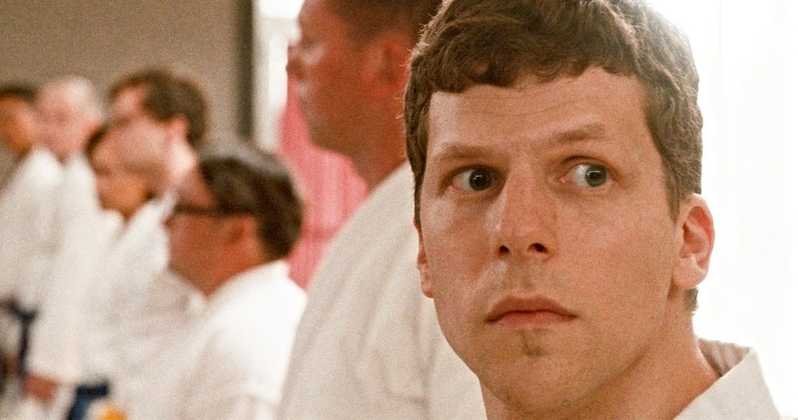Abe Fried-Tanzer reporting from SXSW

How seriously are we supposed to take a movie about Jesse Eisenberg learning karate? Watching The Art of Self-Defense, from director Riley Stearns, there are many different answers to that question. Eisenberg’s lanky frame and token physical awkwardness make his training in martial arts a laughable concept from the start, though its origins are brutal. At the beginning of the film Eisenberg’s Casey is mugged and beaten by masked assailants while walking home with a bag of dog food. This film feels like a parody, but one that's trying to mock too many things...
Before he tries karate, Casey goes to purchase a gun, only to receive a lengthy speech from the gun shop owner about the legal restrictions on the process to do so mixed in with judgments about his personal life and the many ways in which owning a weapon could end up with him hurt. The karate studio lists ten rules about conduct during classes, the last of which is “Guns are for the weak.” Casey is taught instead to “kick with his fist and punch with his feet.” More than susceptible to whatever anyone he talks to says, Casey is particularly hypnotized by Sensei (TFE favorite Alessandro Nivola), who spouts numerous absurd assertions, many of which many of which are overtly and unapologetically sexist, while he teaches. When he cruelly breaks the arm of an overeager student during a demonstration, Casey get his first hint that what he’s gotten himself into may have sinister implications.
Onetime Oscar nominee Eisenberg has toyed with a number of different roles in the past decade or so, ranging from 30 Minutes or Less to Holy Rollers. The types of characters that he plays never vary all that much, and he’s established a recognizable on-screen persona. It’s not a surprise to see him trampled on both literally and metaphorically, and the look of shock in his eyes as he experiences Sensei’s particular teaching style indicates just how uncomfortable he is in his own skin. Yet where Eisenberg truly shines here is when Casey is pushed to be someone else and abruptly shifts his behavior, expressing rage and hatred with expert deadpan delivery.
Casey’s transformation is as hilarious as it is far-fetched. As the happenings at the studio, including Casey’s promotion to the more advanced night class, become increasingly unbelievable, harmless humor is also thrown in. Casey earns high praise from Sensei and his fellow students when he seeks to capture the feeling of wearing his yellow belt all the time by having custom colored belts made for everyone, including a special-order black belt for the Sensei himself. The embrace of this arguably unsophisticated comedy defines the entire film: an entertaining journey with no real center of gravity.